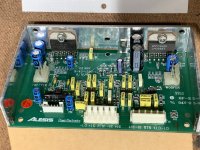Is there any more information available? They look like they could be adapted into a few interesting things…
There is some information, including the schematic, at the Apexjr site, on the "Reference Page". I used to have a lot of info on an old Comcast user page that no longer exists, but most of it can be found in the attached zip file. The amps are well designed and easy to modify, but I found a couple of them with bad ceramic capacitors (they short out and burn the board). For many years I had a four-way stereo amp made from these.
Attachments
Thanks so much for the info Neil, very helpful! I see you shopped at Apexjr as I also bought those Alesis plate biamps and a sheet load of the famous Parapix sub amps. Now I’m on those inexpensive class D TDA3116 modules that can use the 12v rail on the pc psu, easy and I get a solid 14 watts per channel at 8 ohms.
How did you solve the different voltage requirements for the chip amps, can’t find a trans with dual secondaries like that in your pix?
Also what about using the modules as designed by selecting the right drivers in a biamped powered setup?
How did you solve the different voltage requirements for the chip amps, can’t find a trans with dual secondaries like that in your pix?
Also what about using the modules as designed by selecting the right drivers in a biamped powered setup?
I ended up replacing the LM2876 with LM3886 chips, but that was back in the days when those chips were readily available. The tweeter amp has some extra filtering that is designed for the original tweeter and finding a suitable set of replacement drivers for a biamp system might be challenging but probably not too difficult. I never tried to use the amps for a biamped design--I made a number of 3-way and 4-ways systems but bypassed the circuitry that provided compensation for the original tweeter.
- Home
- Amplifiers
- Chip Amps
- Alesis LM3886, LM2876 modules
